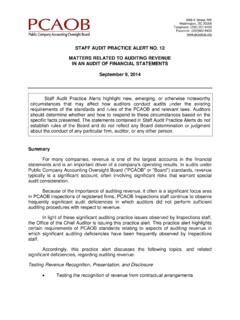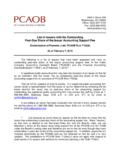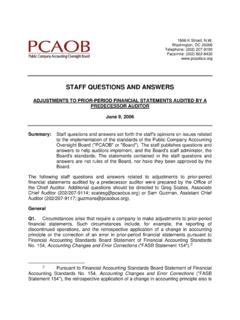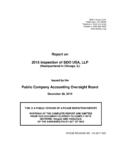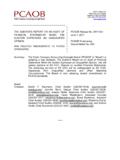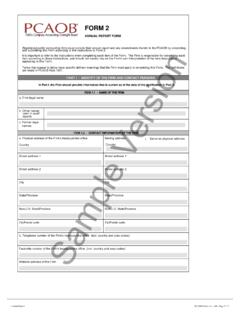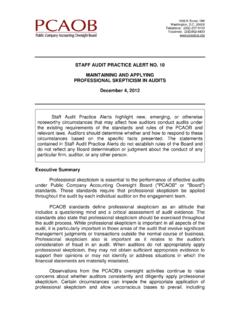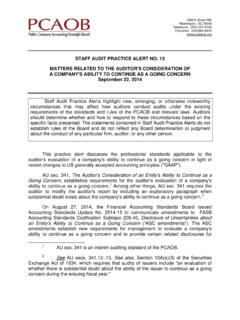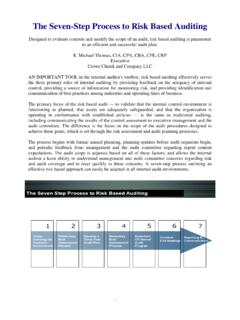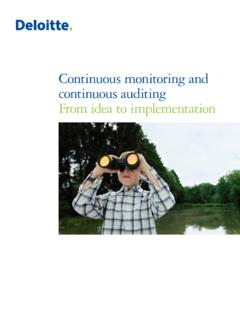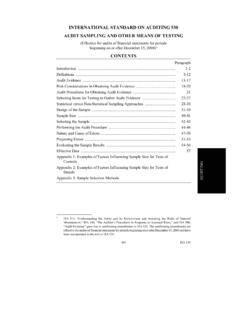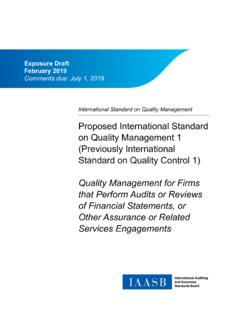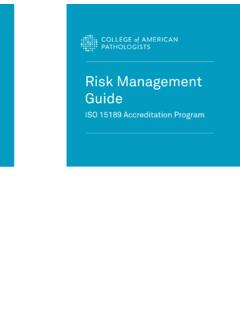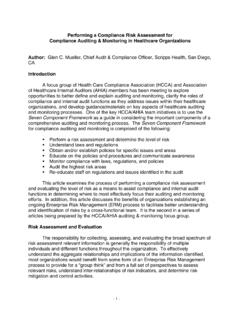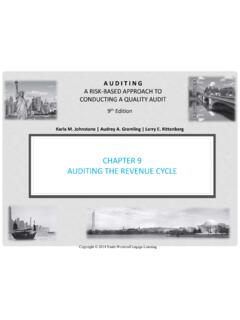Transcription of STANDING ADVISORY GROUP MEETING - PCAOB
1 1666 K Street, NW Washington, 20006 Telephone: (202) 207-9100 Facsimile: (202)862-8430 This paper was developed by the staff of the Office of the Chief Auditor to foster discussion among the members of the SAG. It is not a statement of the Board; nor does it necessarily reflect the views of the Board or PCAOB staff. STANDING ADVISORY GROUP MEETING REASONABLE ASSURANCE OCTOBER 5-6, 2005 Introduction The Board's interim auditing standards1/ require auditors to obtain reasonable assurance that the financial statements are free of material misstatements to support their unqualified opinion on the financial statements. This briefing paper discusses the concept of reasonable assurance and provides information to consider in deciding whether that concept is articulated with sufficient clarity and whether the standard of reasonable assurance is an appropriate level of auditor responsibility for the detection of material misstatements and for evaluating other areas of auditor performance.
2 The Concept of Reasonable Assurance The assurance the auditor obtains from performing procedures and the assurance the auditor expresses in the report on the financial statements vary based on the type of service the auditor provides. An audit is the highest level of service an auditor can provide. An audit allows the auditor to express an opinion about whether 1/ On April 16, 2003, the Board adopted certain pre-existing auditing standards as its interim auditing standards to be used on an initial, transitional basis. PCAOB Rule 3200T describes the auditing standards that the Board adopted and requires registered public accounting firms and their associated persons to comply with these interim auditing standards to the extent not superseded or amended by the Board. See the interim auditing standards at Reasonable Assurance October 5-6, 2005 Page 2 STANDING ADVISORY GROUP MEETING the financial statements are free of material misstatement.
3 In contrast, the objective of a review of interim financial information is to provide the auditor with a basis for communicating whether, as a result of the procedures performed, the auditor became aware of any modifications that should be made to the interim financial information for it to conform with generally accepted accounting principles ("GAAP"). The procedures performed in a review do not provide the auditor with a basis for expressing an opinion on the financial statements. Thus, the assurance the auditor provides to financial statement users based on a review is more limited than the assurance that can be provided as a result of an audit. The term "reasonable assurance," as used in the interim auditing standards, describes the level of assurance auditors are required to obtain by performing audit procedures and evaluating the resulting audit evidence when expressing an opinion that the financial statements are fairly presented in conformity with GAAP.
4 Reasonable assurance refers to the auditor's degree of satisfaction that the evidence obtained during the performance of the audit supports the assertions embodied in the financial statements. The auditor's standard report on the audit of financial statements explicitly asserts in the scope paragraph that the audit was conducted in accordance with professional standards and states that "those standards require that we plan and perform the audit to obtain reasonable assurance about whether the financial statements are free of material misstatement." Defining Reasonable Assurance Paragraph 17 of PCAOB auditing Standard No. 2, An Audit of Internal Control Over Financial Reporting Performed in Conjunction With an Audit of Financial Statements, describes reasonable assurance as follows: Management's assessment of the effectiveness of internal control over financial reporting is expressed at the level of reasonable assurance.
5 Reasonable assurance includes the understanding that there is a remote likelihood that material misstatements will not be prevented or detected on a timely basis. Although not absolute assurance, reasonable assurance is, nevertheless, a high level of assurance. The description of reasonable assurance in PCAOB auditing Standard No. 2, in the context of an audit of internal control over financial reporting, explicitly states that Reasonable Assurance October 5-6, 2005 Page 3 STANDING ADVISORY GROUP MEETING reasonable assurance is a high level of assurance regarding the reliability of financial reporting and the preparation of financial statements for external purposes. However, in the context of a financial statement audit, the term "reasonable assurance" is not explicitly defined. Rather than defining what reasonable assurance is, the interim auditing standards explain reasonable assurance by contrasting it with absolute assurance.
6 For example The auditor has a responsibility to plan and perform the audit to obtain reasonable assurance about whether the financial statements are free of material misstatement, whether caused by error or fraud. Because of the nature of audit evidence and the characteristics of fraud, the auditor is able to obtain reasonable, but not absolute, assurance that material misstatements are detected. The auditor has no responsibility to plan and perform the audit to obtain reasonable assurance that misstatements, whether caused by errors or fraud, that are not material to the financial statements are detected. (AU sec. ) The exercise of due professional care allows the auditor to obtain reasonable assurance that the financial statements are free of material misstatement, whether caused by error or fraud. Absolute assurance is not attainable because of the nature of the audit evidence and the characteristics of fraud.
7 Therefore, an audit conducted in accordance with generally accepted auditing standards may not detect a material misstatement. (AU sec. ) Thus, the interim auditing standards convey the idea that reasonable assurance is less than absolute assurance, but they do not explicitly define reasonable assurance; rather, they state what reasonable assurance is not. Because reasonable assurance is not explicitly defined in the interim auditing standards, both auditors and financial statement users may misunderstand the level of assurance the auditor is required to obtain in an audit before opining on the financial statements. For example, the Public Oversight Board's Panel on Audit Effectiveness ("PAE") expressed concern that auditors may not be requiring as much evidence to Reasonable Assurance October 5-6, 2005 Page 4 STANDING ADVISORY GROUP MEETING achieve reasonable assurance as they have in the past, especially in areas in which they believe that risk is What Level of Assurance Is Reasonable Assurance?
8 Because reasonable assurance is less than absolute assurance, the interim auditing standards are clear that it is less than certainty or, in quantitative terms, less than 100 percent. But how much less is not stated. Some insight into what reasonable assurance means to the auditor may be gained by recognizing that it is the complement of audit risk. Audit risk is defined in AU sec. 312, Audit Risk and Materiality in Conducting an Audit, as "the risk that the auditor may unknowingly fail to appropriately modify his or her opinion on financial statements that are materially misstated." The interim auditing standards describe the relationship between audit risk and assurance as follows The existence of audit risk is recognized in the description of the responsibilities and functions of the independent auditor that states, 'Because of the nature of audit evidence and the characteristics of fraud, the auditor is able to obtain reasonable, but not absolute, assurance that material misstatements are detected.
9 ' (AU sec. ) The interim auditing standards also state the following about the risk/assurance relationship The auditor should plan the audit so that audit risk will be limited to a low level that is, in his or her professional judgment, appropriate for expressing an opinion on the financial statements. (AU sec. ) Audit risk may be assessed in quantitative or nonquantitative terms. (AU sec. ) The auditor should seek to restrict audit risk at the individual account-balance or class-of-transactions level in such a way that will enable him or her, at the completion of the audit, to express an opinion on the financial 2/ Public Oversight Board, The Panel on Audit Effectiveness, Report and Recommendations (2000), par. Reasonable Assurance October 5-6, 2005 Page 5 STANDING ADVISORY GROUP MEETING statements taken as a whole at an appropriately low level of audit risk.
10 (AU sec. ) Because the auditor must limit overall audit risk to a low level, reasonable assurance must be at a high level. Stated in mathematical terms, if audit risk is 5 percent, then the level of assurance is 95 percent. The relationship is not normally quantified at the financial statement level, but the relationship between risk and assurance is incontrovertible, and the interim auditing standards explicitly make the connection. Other professional standards also articulate the concept of reasonable assurance as a high level of assurance. For example, the glossary of terms that accompanies the pronouncements of the International auditing and Assurance Standards Board defines reasonable assurance, both in the context of an audit engagement and quality control, as a high, but not absolute, level of In addition, IFAC's Code of Ethics for Professional Accountants defines an audit engagement as An assurance engagement to provide a high level of assurance that financial statements are free of material misstatement, such as an engagement in accordance with International Standards on auditing .
